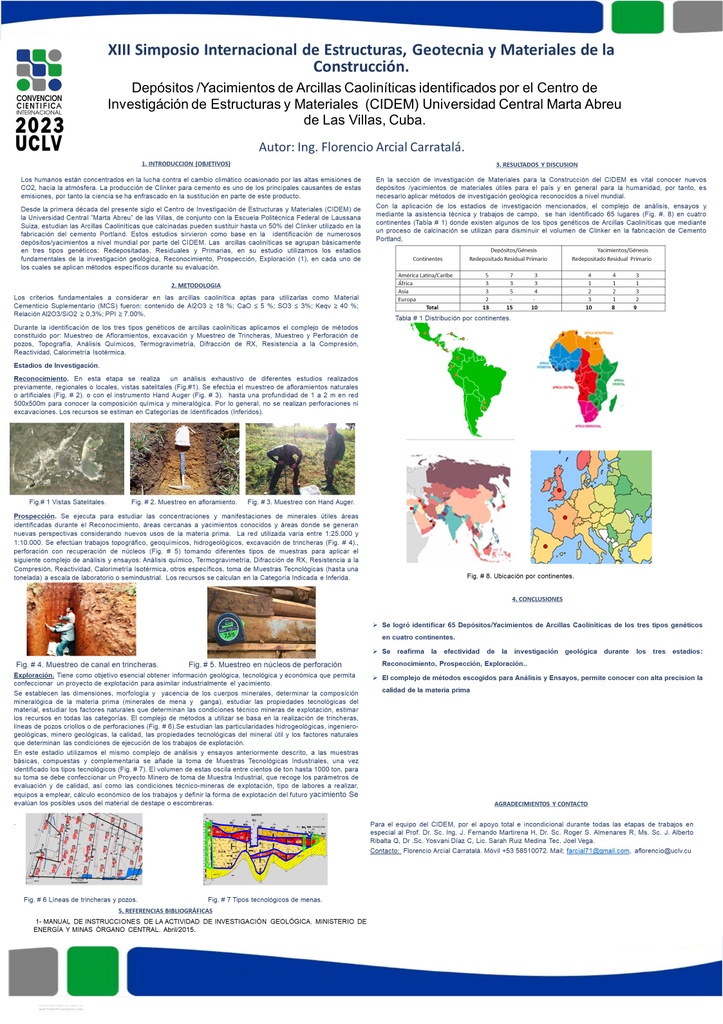Executive Secretary

13rd International Symposium on Structures, Geotechnics and Construction Materials
2nd International Workshop on the production and sustainable use of cement and concrete

Abstract
Reducing CO2 emissions into the atmosphere is of utmost importance today; clinker production accounts for a high percentage of these emissions. Science has been searching for new raw materials to replace part of the clinker in the manufacture of cement.
Through geological research and new analysis and testing complexes, kaolinitic clays have been identified.
The geological investigation was divided into three stages:
Reconnaissance, here all existing documentation of the area was studied and surface sampling was carried out.
Prospecting, based on the results of the reconnaissance, sampling was carried out in excavations and well drilling.
Exploration, carried out in areas studied during prospecting. Samples were taken in excavations, boreholes and an industrial sample of up to 1000 t was taken.
The complex of analysis and testing methods applied in the stages is composed of: Chemical Analysis, Thermogravimetry, X-Ray Diffraction, Compressive Strength, Reactivity, Isothermal Calorimetry.
Using this methodology we were able to identify up to the present time 65 deposits of kaolinitic clays worldwide.
- 65 deposits of kaolinitic clays were identified to be used after calcination in the substitution of clinker.
- The effectiveness of the geological investigation sequence during the three stages was demonstrated.
- It was shown that the selected complex of analysis and tests allows the evaluation of the raw material.
Resumen
Reducir las emisiones de CO2 a la atmósfera, resulta de suma importancia en la actualidad; la producción de Clinker representa un elevado por ciento de estas emisiones. La ciencia se ha dedicado a buscar nuevas materias primas para sustituir parte del Clinker en la fabricación de cemento.
Mediante la investigación geológica y nuevos complejos de análisis y ensayos se ha logrado identificar las Arcillas Caoliníticas.
La investigación geológica se dividió en tres etapas:
Reconocimiento, aquí se estudió toda la documentación existente del área y se realizó un muestreo superficial.
Prospección, se apoyó en los resultados del Reconocimiento, se efectuó muestreos en excavaciones y perforaciones de pozos.
Exploración, ejecutado en áreas estudiadas durante la prospección, Se emplearon muestreos en excavaciones, pozos de perforación y se tomó una Muestra Industrial de hasta 1000 t.
El complejo de métodos de Análisis y Ensayos aplicados en las etapas está compuesto por: Análisis Químicos, Termogravimetría, Difracción de RX, Resistencia a la Compresión, Reactividad, Calorimetría Isotérmica.
Utilizando esta metodología logramos identificar hasta la actualidad 65 Depósitos/Yacimientos a nivel mundial de Arcillas Caoliníticas
• Se identificaron 65 Depósitos yacimientos de Arcillas Caoliníticas para ser utilizadas después de su calcinación en la sustitución del Clinker.
• Se demostró la efectividad de la secuencia de investigación geológica durante las tres etapas.
• Se demostró que el complejo de análisis y ensayos seleccionado permite la evaluación de la materia prima.
About The Speaker

Ing. Florencio Arcial Carratala

Discussion


